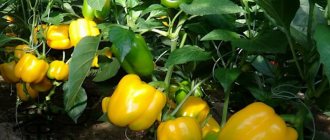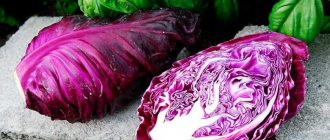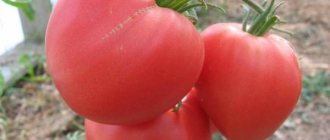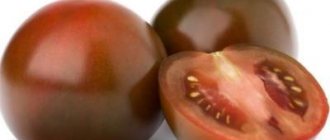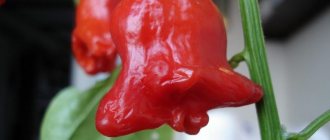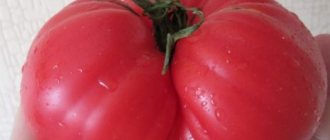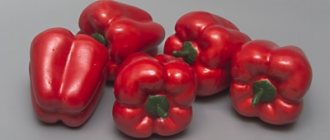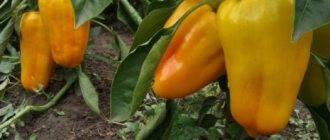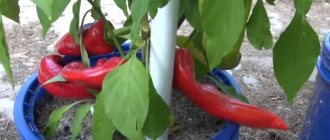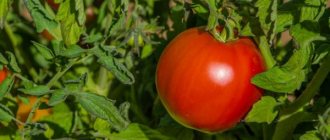Pepper is considered one of the vegetable crops that have firmly established themselves in Russian gardens. Its fruits become part of a large number of vitamin-rich salads and delicious preparations for the winter. In order to improve the taste properties and other indicators, breeders are working hard to create more and more new varieties of their favorite vegetable plant. Among other varieties, the blot pepper attracts attention with the unusual color of the fruit. It is easy to care for and has high yields. The variety was created and entered into the register in 2010. In order not to be disappointed in the choice, it is worth considering the description of the Klyaksa pepper variety, planting and care features, reviews and photos of plants and fruits.
Bright "Blob"
The variety of colors and shapes of bell peppers will delight even the most discerning esthete; among all, the “Blot” variety, with its unusual purple color, especially stands out.
Interesting! It owes its unusual color to the increased content of anthocyanin pigment. This pigment allows the plant to tolerate cold weather well and capture the maximum amount of sunlight, so the fruits ripen even in unfavorable conditions. The average yield is 10 - 12 peppers per bush.
"Snowwhite F1" (Snowwhite F1)
Early ripening hybrid. A highly productive species belonging to the Hungarian waxy type. Suitable for growing in open ground and greenhouses. The fruits are large, weighing up to 160 g. The shape of the berries is cone-shaped, four-lobed, with walls up to 6 mm thick. The coloring is original - from milky to bright orange. Has a great sweet taste. The bush is tall, with a well-developed root system and leaf apparatus. This gives the plant an advantage during hot days. Peculiarities:
- disease resistance;
- beautiful presentation;
- good endurance;
- high yield.
The planting density should not exceed 3 plants per 1 square meter. m in a greenhouse, in open ground - 4.
Description of the variety
Klyaksa is a mid-season, large-fruited variety of bell pepper with high yield. It is good both for growing in open ground and for breeding in greenhouses and hothouses. Has proven itself well in central Russia. It takes 125–135 days from germination to technical maturity. The plant is semi-spreading and can reach 1 meter in height; therefore, in order to form the correct shape of the bush, when it reaches a height of 25–30 cm, you need to pinch the tops.
Advantages and disadvantages
The blot variety has a number of advantages that provide it with a worthy place along with proven varieties of pepper:
- ease of cultivation;
- relative ease of care;
- availability of vaccinations against various infections;
- high yield, reaching 4 kg per square meter (up to 11 fruits per plant);
- appearance and pleasant taste of the fruit.
At the same time, it is worth remembering that growing the variety involves certain conditions. Like all peppers, the type of soil and the presence of fertilizers matter for the blot variety. Fruit growth and ripening also depend on the availability of heat and light.
The only significant drawback that all new varieties suffer from is the high cost of seeds.
For reference. Although breeders classify the Klyaksa pepper as universal, its fruits are best used in salads. During heat treatment, they lose their color, acquiring a dirty green color, so they are not recommended for use in canned foods and hot dishes.
Fruit characteristics
“Klyaksa” is a high-yielding variety, with fruits weighing 130-200 grams, the fruits are aromatic and have a pleasant taste. Cone-shaped, drooping with glossy skin. At technical maturity, the fruits are purple; at the full stage, they are purple-golden. Peppers are universal, good for eating raw, canning and freezing. The fruits are very juicy, have walls of 5–6 mm.
During the growing season, the plant is fed at least 3-4 times.
Attention! Despite its versatility, it is better to use this variety without using heat treatment, otherwise its wonderful color will lose its beauty.
Growing and care
The soil in the beds should be loose and well-drained. Loams and sandstones are suitable for peppers. For 1 m2 the following is added to the soil:
- 5-6 kg of rotted compost;
- 40 g superphosphate;
- 10-15 g of potassium salt.
Place vermicompost in each hole and add 1 tbsp. l. ash. The beds are not watered for a week after transplanting. Then the procedure is carried out with a frequency of 1-3 times a week (monitor the humidity). Feed every 2-3 weeks, alternating organic matter and minerals. The following compositions are used from the complexes:
- Fertika;
- Aqua;
- Lifdrip;
- Agronomist Pro;
- Ideal;
- Blank sheet.
Agricultural technology
Peppers are a rather capricious crop, so they are grown only by seedlings. Sowing of seedlings is carried out in February. It is advisable to first treat the seeds with a solution of potassium permanganate of a deep purple color; if desired, you can soak them in a growth stimulator. Plant feeding begins when the first pair of leaves blooms.
After processing, the seeds are slightly dried, then planted in a pre-moistened substrate. After sprouting, the peppers are mulched with peat or a mixture of earth and humus.
At least 50 days after germination, seedlings can be planted in open ground. Planting pattern 60x40 cm. Sweet pepper responds favorably to watering, but does not tolerate excess moisture, so you should not water too much, but often.
Important! Timely shaping of bushes helps to significantly increase productivity!
https://youtu.be/nu7X-zjGamI
Landing
The seeds are treated the day before sowing. First, soak in warm water, then disinfect in potassium permanganate or Fitosporin. To activate germination, use Epin, Agate (process for 4-5 hours). The seed material is laid out on moistened gauze; the fabric is not allowed to dry out. The seeds will sprout and roots will appear in 4-6 days. They are transferred into the holes using tweezers and planted to a depth of 1 cm.
For seedlings, boxes, containers, and pots are used. The soil used is turf-compost with the addition of ash and sand. Until germination, the containers are kept warm under film.
Seedlings appear after 5-8 days.
The seedlings are kept on a well-lit windowsill or shelf. In the evening, turn on the phytolamps for 4-5 hours. Picking is carried out in the phase of 1-2 leaves. Before and after this procedure (a week), liquid fertilizer is applied. Use a diluted solution of mullein, Azotovit, urea, and saltpeter.
At 55-65 days, the bushes are transplanted to a permanent place. There are 5 plants per 1 m2.
Reviews
Alexandra, Stavropol region
I am an experienced gardener, I love peppers very much, I have been growing them for a long time and have tried many different types. I tried the blot for the first time two years ago. I really liked the variety for its unpretentiousness. And the family loved it for its unusual color. Salads with it look very elegant.
Gennady, Voronezh
I am engaged in growing seedlings for sale. The variety is for everyone. Germination is good, the seedlings are strong. Some are put off by the color of the future fruits, but those who are familiar with the variety are willing to buy. It is very loved by summer residents who do not have time to meticulously care for plants.
Review: Pepper seeds Search “Blot” – An unusual variety of pepper, wonderful appearance.
Good day to the readers of this review! Peppers take second place among plants that are interesting to grow and can surprise with unusual results. For example, my favorite variety is Klyaksa from the manufacturer Search. To fully reap the harvest, I sow peppers for seedlings early, in the first ten days of February. Since they don’t like transplanting, I plant two seeds in pots and then leave the stronger plant. The germination rate of this variety is excellent, two and sprouted. The sprouts appeared in the photo on the 22nd.
Last year I decided to grow them in buckets, there was already a successful way of growing them this way, it’s convenient because there is no need to protect them from slugs, they don’t get here. But be sure to add vermiculite to them to protect the roots from drying out. In May, I transplanted them and kept them in a greenhouse until steadily warm weather arrived; this photo is from the first of June.
With the onset of warm days, they moved to my free space outside, the advantage is that they can be moved and placed anywhere free, choosing a sunny place. The fruits began to grow actively and, having reached a certain size, change color. Caring for them, as in greenhouses, removing excess leaves and shoots, feeding.
Diseases and pests
The blot pepper variety is susceptible to most diseases of this crop. Summer residents face the difficult task of protecting plants from viral and fungal infections that are common in the garden; this requires:
- Do not plant peppers in beds after nightshade crops (potatoes, tomatoes, eggplants), as pathogenic microbes may remain in the soil. The culture can be returned to its original place no earlier than after 3 years.
- Do not leave diseased plants on the site - it is best to burn them immediately.
- If a greenhouse is used, it must be disinfected. In addition, not only the walls and racks of the greenhouse are subjected to treatment, but also the equipment and all the soil. Copper sulfate, potassium permanganate solution, and other preparations are used as disinfectants.
- Seeds, seedlings, soil for seedlings - everything must be subjected to disinfection treatment.
- During the growing process, to prevent diseases of peppers, spraying with preparations such as phytosporin and Bordeaux mixture is used.
Most often, peppers suffer from the following diseases:
- Blackleg - this disease is considered a seedling disease, since young plants are most affected. The disease is of fungal origin and is transmitted through seeds and soil. The development of the disease is promoted by high air humidity and low temperature. To prevent the disease, it is recommended to ventilate greenhouses, and periodically water young plants with a weak solution of potassium permanganate.
- Phytoplasmosis or stolbur is caused by pathogenic microorganisms that first affect only the shoots, and then the entire plant. There are no means to combat the disease, so the only way out is to destroy diseased plants and disinfect equipment and soil.
- Late blight, the most dangerous disease that often affects nightshade crops, is caused by a fungus that spreads especially quickly at high humidity and low temperatures. The disease begins with the appearance of brownish spots on the leaves, which gradually spread to the stems and fruits. To combat the disease, preventive treatment of plants with phytosporin and copper-containing preparations is used.
- Blossom rot is a disease that sometimes occurs in plants that have an excess of nitrogen in the diet with a lack of calcium. Weeping spots first appear on the tops of plants, gradually spreading to the entire plant, including the fruits. It is important not to miss this disease, especially since its spread can be avoided by feeding the plants with calcium nitrate.
Description of sweet pepper Klyaksa, reviews, photos
Mid-season, large-fruited, productive variety of sweet pepper. Recommended for growing in open ground and film greenhouses. It takes 120-130 days from germination to the start of fruiting.
The bush is semi-spreading, up to 1 meter high. The leaf is medium sized, green, slightly wrinkled.
The bell pepper variety Klyaksa was included in the State Register of the Russian Federation in 2010.
Fruit characteristics
pepper Klyaksa in technical ripeness
The fruits are drooping, cone-shaped, glossy, purple in the stage of technical ripeness, red in the biological stage, weighing 120-200 grams, excellent taste without bitterness. Wall thickness 6 mm. These peppers are suitable for fresh consumption, stuffing, making lecho, and freezing.
Productivity : up to 3.5 kg/sq.m (subject to agricultural practices).
I didn’t like it: it’s not beautiful in dishes, because... Only the skin has a beautiful purple color, the flesh is whitish, and the taste is also watery.
Sweet, 50-60 cm high, the wall is not thick. I really liked the taste, as if you were eating without pepper...it’s delicious for me.....
There are no similar posts
How to grow seedlings yourself
You can grow pepper seedlings yourself.
Sowing of seeds begins in March in a container with light fertile soil. The first shoots appear within a week. Beginners usually do not pay much attention to the quality of planting material, and in most cases they fail because of this. When planting, you need to pay special attention to the quality of the seeds. Choose only trusted suppliers.
- After planting, the soil should be watered with an antifungal solution. To plant this plant, take a shallow container and make drainage in it.
- After this, pour soil into this container and sow the seeds, having previously treated them with a stimulant solution.
Overall, growing peppers from seeds is not difficult. In this matter, the main thing is to strictly follow the planting recommendations and everything will be fine. Seeds should be planted in soil that has been passed through a sieve. For a couple of days, you need to cover the containers with a plastic bag or glass.
- First, thoroughly sift the top layer of soil mixture. Then fill the pots or other containers with it.
- Before planting, be sure to treat the soil with some kind of fungicidal agent.
- After the above event, the soil must be left alone for some time until it dries completely.
- Then simply pour the seeds onto the ground and sprinkle soil on top. After that, water the whole thing generously. Young plants with three leaves are transplanted into a separate container. After 10 days, the seedlings are fertilized. Pepper needs warmth and no drafts.
- There is no need to use any special techniques. The main reason why pepper seedlings may die is a sharp drop in soil temperature.
- If you have a heated greenhouse, then you can start growing seedlings of the Klyaksa pepper variety from April 10.
- March is considered a favorable period for sowing seeds in boxes in an apartment on the windowsill. The seedlings need to be thinned out; if this is not done, the seedlings will stretch out. It is recommended to illuminate the seedlings in the morning and evening for two hours.
- Water the pepper with warm water. The most important thing is the presence of heat. It is better to plant peppers a month later than expected, but in the end you will get a higher yield. Sometimes it happens that plants in containers rot due to the spread of soft bacterial rot. In this case, diseased plants should be removed and the soil treated with a solution of potassium permanganate.
pepper Claudio F1 - description and characteristics of the variety
